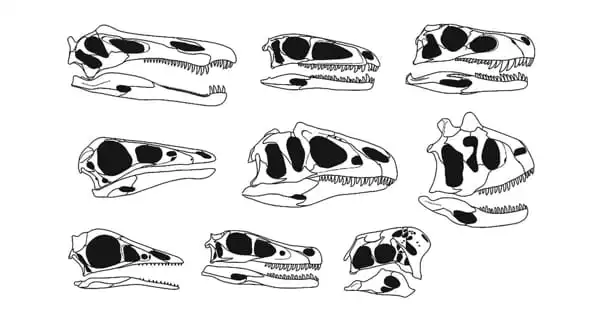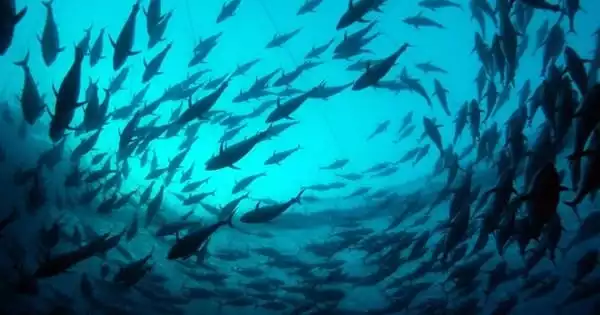Spinosaurus is the largest predatory dinosaur known, measuring more than two metres longer than the longest Tyrannosaurus rex, yet how it hunted has been a source of contention for decades. A group of palaeontologists used a novel approach to deciphering the lifestyle of long-extinct species in a new research published today in Nature: they examined the density of their bones.
The team discovered that Spinosaurus and its close relative Baryonyx from the Cretaceous of the UK both had dense bones that would have allowed them to submerge themselves underwater to hunt by analyzing the density of spinosaurid bones and comparing them to other animals such as penguins, hippos, and alligators.
Spinosaurids were known to have water affinities; their elongate jaws and cone-shaped teeth are comparable to those of fish-eating carnivores, and the ribcage of Baryonyx from Surrey even included half-digested fish scales.
Dr. Nizar Ibrahim, a palaeontologist at the University of Portsmouth and a National Geographic Explorer, discovered various fragments of a Spinosaurus skeleton in North Africa’s Sahara Desert over the last decade. The skeleton revealed by Dr. Ibrahim and his colleagues had retracted nostrils, small hind legs, paddle-like feet, and a fin-like tail, all of which strongly suggested an aquatic lifestyle.
“We braved sandstorms, flooding, snakes, scorpions, and more to dig the world’s most perplexing dinosaur, and now we have several lines of evidence all pointing in the same direction — the skeleton truly has “water-loving dinosaur” written all over it!” said Dr. Ibrahim.
We braved sandstorms, flooding, snakes, scorpions, and more to dig the world’s most perplexing dinosaur, and now we have several lines of evidence all pointing in the same direction — the skeleton truly has “water-loving dinosaur” written all over it!
Dr. Ibrahim
Dr. Ibrahim and his team earlier argued that Spinosaurus could swim and actively chase prey in the water-based on its highly specialized anatomy, but others stated that it was not much of a swimmer and instead trudged in the water like a huge heron.
Researchers have been debating whether Spinosaurus spent most of its time submerged, seeking prey in the water, or if it simply stood in the shallows and dipped its jaws in to catch prey. “In part, this is probably because we were disputing decade-old dogma — so even if you have a very compelling argument, you kind of expect some resistance,” Dr. Ibrahim explained.
This ongoing disagreement prompted lead author Dr. Matteo Fabbri of Chicago’s Field Museum, senior author Dr. Ibrahim, and an international team of researchers to try to find another approach to infer the lifestyle and ecology of long-extinct creatures like Spinosaurus.
Dr. Fabbri stated: “Okay, clearly, we can interpret the fossil data in numerous ways, so that was the purpose behind our work. But what about physical laws in general? There are certain laws that apply to all organisms on the earth. One of these laws concerns density and the ability to submerge in water.”
Bone density can tell us whether an animal can sink beneath the surface and swim across the animal kingdom. “Previous studies have shown that mammals adapted to water have dense, compact bone in their postcranial (behind the skull) skeletons,” said Fabbri, an expert on the internal structure of bone. Dense bone aids in buoyancy control and allows the animal to submerge.

The researchers compiled a massive collection of femur and rib bone cross-sections from 250 species of extinct and current animals, comprising both land and water dwellers and animals from a few grams to several tonnes, including seals, whales, elephants, mice, and even hummingbirds.
They also acquired information on extinct sea reptiles such as mosasaurs and plesiosaurs. The researchers matched the bone cross sections of these animals to those of Spinosaurus and its relatives Baryonyx and Suchomimus.
“The scope of our study kept extending because we kept thinking of more and more groups of vertebrates to include,” Dr. Ibrahim explained.
The researchers discovered a definite correlation between bone density and aquatic foraging behavior: animals who submerge themselves below to gather food have bones that are almost totally solid throughout, whereas cross-sections of land-dwellers’ bones resemble doughnuts with hollow centers. When the researchers used this paradigm to spinosaurid dinosaur bones, they discovered that Spinosaurus and Baryonyx both had the type of thick bone associated with full submersion.
Meanwhile, the closely similar African Suchomimus possessed hollower bones. It still lived near water and ate fish, as demonstrated by its crocodile-like snout and conical teeth, but based on its bone density, it wasn’t swimming much. “That was a bit of a surprise,” Ibrahim says, “since Baryonyx and Suchomimus appear rather similar.” However, the team quickly realized that it was not out of the norm, and comparable patterns may be seen in other groups.
Other dinosaurs, such as the large long-necked sauropods, had solid bones in their limbs as well, but this simply reflected the enormous amount of stress on those limb bones. “Some of these animals would have weighed as much as several elephants,” Dr. Ibrahim added, “so adding extra load-bearing capability to the bones makes a lot of sense!”
Dr. Jingmai O’Connor, a curator at the Field Museum and co-author of this work, believes that collaborative studies involving hundreds of specimens are important “Palaeontology’s future. They take a long time to complete, but they allow scientists to shed light on large patterns.”
Dr. Ibrahim is already planning his next set of inquiries. “With this new line of data, I believe that speculative views of Spinosaurus as a huge wader are no longer supported by evidence and can be safely dismissed. The bones don’t lie, and we now know that even the internal architecture of the bones is fully consistent with our view of this animal as a massive predator hunting fish in enormous rivers, propelled by its paddle-like tail. It will be fascinating to rebuild how these river monsters moved in greater detail – something we are currently working on.”
















